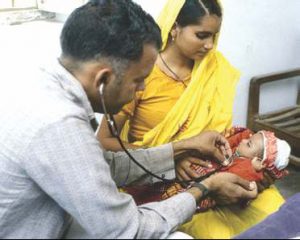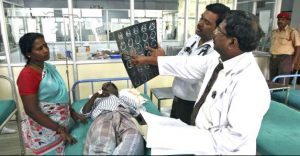‘Ayushman Bharat’, the biggest health financing scheme in the world, aims to create a network of health and wellness infrastructure across the nation in delivering comprehensive primary healthcare.
India’s constitution guarantees free healthcare for all its citizens, but in practice the private healthcare sector is responsible for the majority of healthcare in India, and most healthcare expenses are paid out of pocket by patients and their families, rather than through insurance. All government hospitals are to provide healthcare free of cost.
Pradhan Mantri Jan Arogya Abhiyan/ Ayushman Bharat Yojana and/or also known as National Health Protection Scheme is a program which aims to provide a service to create a healthy, capable and content new India. The biggest health financing scheme in the world, offers an insurance cover of Rs 5 lakh, which is expected to cover 10 crore poor families or almost 50 crore persons.
The goal of the scheme is to create a network of health and wellness infrastructure across the nation to deliver comprehensive primary healthcare, and to provide insurance cover to be at least 40 per cent of India’s population which is majorly deprived of secondary and tertiary care services. Prime Minister Narendra Modi recently announced the scheme during his 2018 Independence Day, following its launch in September.
Targeted audience
The scheme is targeted at poor, deprived rural families and identified occupational category of urban workers’ families. The scheme ensures that adding no cap on the family size and age under AB-NHPS leaves nobody out. It is cashless and paperless at public hospitals and empanelled private hospitals.
“PMJAY – Ayushman Bharat is the biggest government-sponsored healthcare scheme in the world. The number of beneficiaries is almost equal to the population of Canada, Mexico and the US taken together,” PM Modi said.
“PMJAY Ayushman Bharat is the biggest government-sponsored healthcare scheme in the world. The number of
beneficiaries is almost equal to the population of Canada, Mexico and the US taken together.”
– Narendra Modi, Prime Minister, India
The magnitude of the scheme could be gauged from the fact that more than 1,300 ailments are covered under it including heart diseases, kidney and liver disorders and diabetes, he added.
“People are calling the scheme Modicare and by other names, but for me it is an opportunity to serve the poor. Even the ones living in the lowest strata of the society will benefit from the scheme.
“I hope and pray that the poor do not have to visit hospitals, but, if they do, the Ayushman cover will be at their service. The poor of my country must get all the facilities that the rich enjoy,” the Prime Minister underlined.
According to the PM, this healthcare scheme will set an example for countries across the world. Around 13,000 hospitals have already signed up for Ayushman Bharat scheme, and the government aims to take a holistic approach to lay stress on affordable and preventive healthcare.
The PM also announced that while the scheme will initially cover 10 crore poor families as per the socio-economies census of 2011, it will “in the coming days also benefit the lower-middle income, middle class and upper middle class” by way of jobs in the medical sector as new hospitals will open in Tier 2 and Tier 3 cities.
Changing healthcare landscape
According to local media, the growing population and ascend in chronic care needs are wielding substantial demands on India’s healthcare frameworks. It is greatly stressing that about 50-60 million Indians are constrained to spend half of their yearly family income to address medical issues, particularly with regards to hospitalization.
The out-of-pocket costs for medical services are extremely high for, which influence disservice to almost 7 per cent of the Indian population. Access to capital has been one of the biggest roadblocks to the growth of the Indian healthcare sector.
Today, majority of the system constitutes of private healthcare and the Indian government spends only about 1 per cent of its GDP on healthcare, which is among the lowest globally for any country. However, to meet India’s burgeoning healthcare needs, both the public and private sector will have to join hands to build value-based and cashless healthcare. This implies providing a high-end care at a subsidized cost compared to other countries; to enhance healthcare services.
It is the commitment of the state to give free and universal access to quality healthcare services to its citizens as India keeps on being among the nations of the world that has a high proportion of ailments. The various well-being projects and policies in the past have not possessed the capacity to accomplish the coveted objectives and targets.
However, the recent launch of one of the major policy initiatives by the government, Ayushman Bharat National Health Protection Mission for the underprivileged section of Indian population, will help in the accomplishment of the dream of Universal Health Coverage of the Indian population.
Ayushman Bharat is an attempt to ensure that universal healthcare reaches the weaker section of the society and it may certainly boost the ratio of people availing primary healthcare and some of the secondary healthcare. But the current framework of the scheme will not be beneficial for people who need tertiary care as the remunerations under the scheme will not be sufficient to avail value based healthcare.
Under the scheme, tertiary healthcare service providers will be forced to cut costs at every level, which will lead to offering a sub-standard healthcare to patients under the scheme. They may not be able to avail the necessary medication, technology and clinical expertise to get the best outcome and will soon lose confidence in the system.
Strengthening infrastructure
Giving financial protection to the poor not only gives them access to healthcare but also is cost-effective. That is, it gives great incentives as the advantages of financial protection far exceed the expenses. However, cost-effective health coverage must cover primary care.
 The World Health Organization (WHO) prescribes allotment to primary care, particularly for presently unprivileged low-income population. In India, reallocation of assets is important to fortify primary care and to embrace innovation and well-being programs, to be cost-effective in terms of expenses and anticipated benefits.
The World Health Organization (WHO) prescribes allotment to primary care, particularly for presently unprivileged low-income population. In India, reallocation of assets is important to fortify primary care and to embrace innovation and well-being programs, to be cost-effective in terms of expenses and anticipated benefits.
The scheme is the commitment of the state to give free and universal access to quality healthcare services to its citizens as India keeps on being among the nations of the world that has a high proportion of ailments. The various well-being projects and policies in the past have not possessed the capacity to accomplish the coveted
objectives and targets.
 Solid primary care is crucial to keeping overall access to healthcare reasonable and inexpensive in the nation. India’s greatest imperative to getting this going is not lack of capital or framework, but an intense deficiency of human resources and infrastructure. Most public healthcare facilities have noteworthy deficiency of specialists, doctors, nurses and other healthcare experts.
Solid primary care is crucial to keeping overall access to healthcare reasonable and inexpensive in the nation. India’s greatest imperative to getting this going is not lack of capital or framework, but an intense deficiency of human resources and infrastructure. Most public healthcare facilities have noteworthy deficiency of specialists, doctors, nurses and other healthcare experts.
To address this, the government should use existing foundation in private medical schools that has been under-used because individuals cannot afford the cost of it. To utilize these spaces, bundle rates must be made competitive and at standard with the market rates.
The government says that volumes will help take care of the expenses, yet that is after a point of time. Now, they must get the beneficiaries, and make it reasonable for the hospitals as well.
Quality Healthcare
Quality Healthcare is defined as value-based medicine that is assessed by outcome. Today, nearly 80 per cent of healthcare in India is provided by the private healthcare system and in order to meet the burgeoning healthcare needs of Indian population through value based medicine, the country needs a synchronized effort by both private and public sector.
The scheme further encourages hospitals to maintain certain minimum standards. The reward to hospitals is 10 per cent higher if they have National Accreditation Board for Hospitals and Healthcare Providers (NABH) accreditation and a basic technology criterion has been stated for hospitals to be qualified for this scheme.
Solid primary care is crucial to keeping overall access to healthcare reasonable and inexpensive in the nation. India’s greatest imperative to getting this going is not lack of capital or framework, but an intense deficiency of human resources and infrastructure. Most public healthcare facilities have noteworthy deficiency of specialists, doctors, nurses and other healthcare experts.
Hospitals that meet certain quality benchmarks ought to be permitted to serve NHPS beneficiaries. Quality should be assessed not only by the infrastructure offered at the hospital but also by authentic patient outcomes attained.
















